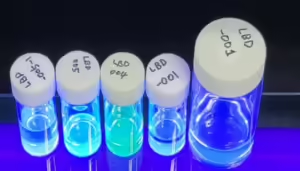Researchers have developed a new OLED design that combines a p-type host and a blue fluorescent dopant, creating a breakthrough called the ZETPLEX (zero-radius of intramolecular energy transfer in exciplex) mechanism. Lordin, in collaboration with various Korean academic institutions (Hongik University, Gachon University, and Dankook University), has published a study in Advanced Materials that it claims surpasses Samsung Display’s blue phosphorescent OLED research from two years ago.
Although South Korea leads in OLED panel manufacturing, it relies on Universal Display Corporation (UDC), a US-based company, for key manufacturing materials. Every time companies like LG or Samsung sell OLED TVs, a portion of the profits goes to UDC in royalties, says Oh Hyung-Yoon, CEO and founder of Lordin, and despite being dominant in OLED materials, UDC has yet to solve the challenge of developing blue light-emitting materials.
In a post on the company’s site, Oh expressed frustration that despite Korea’s excellence in displayy manufacturing, it lags behind the US and Japan in materials technology and he emphasized the need for Korea to complete the development of blue OLED materials. This value of this new research carries some patriotic heft for Korea’s display industry.
The emissive layer (EML) in OLEDs is a layer made up of organic materials that emit light when an electric current is applied. In an OLED, the EML typically contains a combination of host materials and dopants (such as fluorescent or phosphorescent materials) that work together to produce light in different colors (red, green, blue). The efficiency and color purity of the OLED depend heavily on the composition and design of the EML, making it a critical component for high-performance OLED displays. The researchers wanted to address the limitations of multi-component EML systems, such as difficulties in controlling mixing ratios, high production costs, and the complexity of photophysical properties in OLEDs. Traditional 3-component EML systems, although effective, present challenges in achieving optimal energy transfer between the host and dopant materials.
To overcome these challenges, the researchers designed and synthesized a fused pH-FD molecule, which effectively combines the roles of both the p-type host and blue fluorescent dopant in a single molecule. This design allows for a seamless transfer of energy between the exciplex (formed between the pH and nH) and the FD unit, bypassing the need for the conventional multi-component system.
By implementing the ZETPLEX mechanism, the paper reports an external quantum efficiency (EQE) of 14.9% for the 2-component OLED device, which surpasses the EQE of the traditional 3-component system (12.2%). This efficiency is attributed to the zero-radius energy transfer, which eliminates energy loss that commonly occurs in the traditional Förster and Dexter energy transfer mechanisms.
The team has secured a structural patent for this innovative molecular design and anticipates strong competitiveness in mass production due to the improvements in material efficiency, color purity, and device lifespan. They plan to continue research to combine both TADF and phosphorescent approaches, with more papers to be published early next year.
Reference
Na Song, Y., Bae Park, B., Lee, H., Kang, S., Pyo Hong, W., Yun Oh, H., & Kim, T. (2024). Non-conventional exciplex system by leveraging zero-radius of intramolecular energy transfer mechanism: Seamless integration of p-host and fluorescent dopant for highly efficient OLEDs. Chemical Engineering Journal, 492, 152371. https://doi.org/10.1016/j.cej.2024.152371

